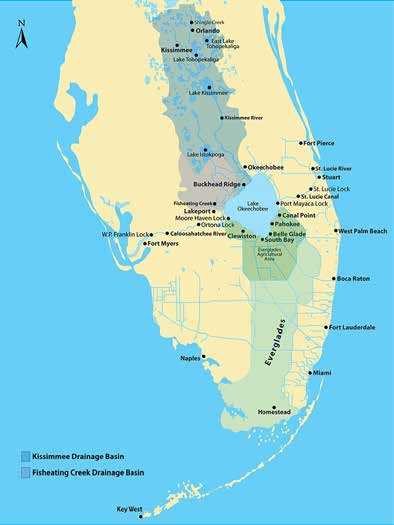From North to South, WATER POLICY IS COMPLEX

Reg Buxton Life in Naples Publisher
Let’s start this article from the top. By that I mean from the water that flows from
Orlando south to Naples. This flow goes from the Greater Orlando area with its many
septic tanks and flows southward through the Kissimmee River basin picking up agricultural runoff, septic tank discharge along the way to Lake Okeechobee. We are all familiar with what happens to the water during high rain events/seasons and the
releases from Lake Okeechobee.
In the 1960’s the Army Corps of Engineers changed the Kissimmee River from a meandering waterway into a straight ditch that ran south directly into Lake O. The goal at the time was for inland freight navigation. However, without the bends and oxbows, the Kissimmee River lost its ability to cleanse the water as it flowed south adding huge amounts of pollutants to Lake O.
 Started in the 1990’s and finished in 2015 the Kissimmee River Restoration project re-channelized the waterway to replicate its natural paths. With these improvements to the ecosystem, birds and other wildlife responded quickly and demonstrated the resiliency of nature. This success has been used all
Started in the 1990’s and finished in 2015 the Kissimmee River Restoration project re-channelized the waterway to replicate its natural paths. With these improvements to the ecosystem, birds and other wildlife responded quickly and demonstrated the resiliency of nature. This success has been used all
over the world to justify the value of ecosystem restoration.
Another matter for concern is the buildup of chemical infused sediment in Lake O. When the water gets too high in Lake O water that historically flowed to the Everglades is now discharged to the Caloosahatchee and St Lucie Rivers and estuaries. These sediments are “kicked-up” during high wind and rain events and then flow south and east to the Everglades and west as it rushes down the Caloosahatchee River.
The excess pollution from the Kissimmee River Basin and the freshwater intrusion create unnatural salinity levels and fuel algae blooms that can kill aquatic life. The toxins made by the harmful algae blooms can have serious health risks to the public. During the dry season the Caloosahatchee can be cut off from any flow from Lake O. This causes the river to stagnate. Having either too much or too little flow combined with the basin runoff pollution is seriously damaging the Caloosahatchee River and its estuaries; the very basis of this region’s tourist based economy.
The Caloosahatchee River was connected years ago to Lake O by a dredged canal so it would divert water that used to flow south of Lake O to the Everglades This was done to make channels better and create
the Everglades Agricultural Area (EAA) an area of the Everglades that was drained and used for sugarcane, sod, sweet corn and cabbage agribusiness production. Lake O’s outlets are a few small canals
instead of the much larger flow south of the lake.
Now when the lake level gets too deep, water must be discharged east to the St Lucie River and west to the Caloosahatchee instead of flowing south through its natural and historical track. All along the rivers journey the water picks up additional phosphorus and nitrogen rich fertilizers from dense suburban
developments, golf courses, resorts and agricultural operations.
The construction of canals in areas like Cape Coral, Palm Coast, Sewall’s Point and many other “waterfront“ communities in Florida from the 1960’s to the present day also compound the problem with
waterways that only ebb and flow with the tides. Meaning there is relatively no current throughout the day other than tidal changes to move the water about and prevent higher water temperature and the
pooling of nutrient rich compounds.
In addition, nutrient pollution from on-site sewage systems (septic tanks), landscaping fertilizer, and manure has reached unsafe levels throughout Florida due to urban and agricultural runoff. Agriculture
and urban/suburban developments are also not being required to adequately retain and treat runoff on-site. Lack of compliance and enforcement has resulted in too much pollution getting into waterways and flowing downstream.
The Conservancy of Southwest Florida advocates a comprehensive approach to restore, clean and return the appropriate historical flows to the Caloosahatchee and the Everglades. They advocate for science
based solutions that would benefit the environment, public health and safety of all communities in southern Florida.
Their advocacy includes the following actions to fix the water crisis:
• Authorize and fund the Everglades Agricultural Area Reservoir to expedite the funding and construction of a critical missing piece of the restoration puzzle to help reduce the harmful discharges and send clean water south.
• Retain and treat more water within the Caloosahatchee watershed.
• Protect remaining natural wetlands and flow ways in order to maintain existing natural storage and treatment capacity.
• Control pollution at its source with on-site storm water retention and/or storm water utilities systems.
The ripple effect as polluted water releases from Lake O continues to rush down the Caloosahatchee River, dark, dirty water and algae blooms plague the estuaries and beaches and threaten our greatest
economic engine – Tourism.
We are experiencing the ripple effects first hand: Seagrasses are lost: Seagrass is a main source of food for juvenile fish and manatees. Seagrass dies when the water’s salinity swings outside of natural ranges. The salinity changes when the river is subjected to harmfully high or insufficient water flows. Sport fishing industry suffers: Juvenile fish die as a result of poor water quality, less habitat and lower oxygen levels in the water caused by pollution and nutrient fueled algae outbreaks. Fewer juvenile fish
mean fewer game fish.
As a coastal community that is fully developed and engaged now in redevelopment, we have concerns about protecting our Gulf of Mexico and the beautiful waterways that make our home special. However, the solution set is complex from a macro-State of Florida perspective. The economy of Florida is a three-legged stool with tourism, development/redevelopment and agriculture making the tripod foundation.
The solutions must be balanced in order to improve and sustain our natural environment, but also to keep our state economy strong. Without taking into account these three elements of our overall economy, policies addressing the water supply, water quality and environmental restoration/protection will be myopic and assuredly will throw the state economy out of balance.
A strong ecosystem is good for all of us. The decisions have to be based on science, best management practices and enforceability. The solutions sets to address the nutrient loading from septic tanks, fertilizers and storm water runoff is neither cheap nor convenient. However, there seems to be a glimmer of hope as we can all agree on one thing, the status quo is not sufficient.
Sources:
Conservancy of South West Florida
– Audubon Florida – C Chapman IV
– Florida Atlantic University



Leave a Reply
Want to join the discussion?Feel free to contribute!